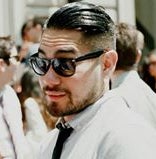
The Kryptos Sculpture is an encrypted sculpture made by artist Jim Sanborn in 1990, and is located at the CIA headquarters in Langley, Virginia. As told in Wired, the sculpture is broken into four parts composed from 1,800 letters carved out of copper plate, with the first three parts having been solved by CIA cryptoanalyst David Stein in 1998. The fourth section is considered one of the most famous unsolved mysteries in the world.
Stein took more than 400 hours during his lunch breaks at Langley to decipher the first three parts of the sculpture, using nothing but pencil and paper. He wrote about his tale a short while after, which you can read here.
A year later in 1999, California computer scientist Jim Gillogly boasted that he, too, solved the first three sections. Except he used a Pentium II to do it. Since the fourth code was (and still is) seemingly insurmountable, there seemed to be a race to crack the first three codes, since they were shown to be possible. Except, Stein and Gillogy weren't even the first ones to do it. They had already been beaten years before—by the NSA.
According to recently released documents, in 1992—two years after the sculpture was completed—Adm. William O. Studeman, the CIA's then director and former NSA director, challenged the NSA to crack the code. The NSA's director back then, Vice Admiral Mike McConnell, announced the challenge to the NSA during an internal ceremony. A few people from the Z group (the code name for the cryptanalysts division), responded to the call.

A year earlier, NSA interns on a trip to the CIA had written each line of code down onto paper, which the Z group then worked from. They quickly discovered that the sculpture was broken into four parts, and within two days, the team of three solved the first three sections of the puzzle. What about the infamous fourth section? "A decision was made to stop any further work” on the code, they wrote in a memo. “Given the suspected cryptography, the last section is too short to solve without diverting a great deal of effort from operational problems."
In 1993, a note announcing the achievement was sent to Admiral McConnell. He quickly asked for the memo to be forwarded to his counterpart at the CIA, Admiral Studeman, to boast that the NSA had solved the CIA's own puzzle.
The artist of the sculpture, Jim Sanborn, revealed six of the 97 letters of the final fourth part of the sculpture in 2010, after he was surprised that it had gone unsolved for so long. The letters — NYPVTT — when deciphered, spell out “Berlin.”
The solutions to the first three parts are listed below:
Part One: BETWEEN SUBTLE SHADING AND THE ABSENCE OF LIGHT LIES THE NUANCE OF IQLUSION
Part Two: IT WAS TOTALLY INVISIBLE HOWS THAT POSSIBLE ? THEY USED THE EARTHS MAGNETIC FIELD X THE INFORMATION WAS GATHERED AND TRANSMITTED UNDERGRUUND TO AN UNKNOWN LOCATION X DOES LANGLEY KNOW ABOUT THIS ? THEY SHOULD ITS BURIED OUT THERE SOMEWHERE X WHO KNOWS THE EXACT LOCATION ? ONLY WW THIS WAS HIS LAST MESSAGE X THIRTY EIGHT DEGREES FIFTY SEVEN MINUTES SIX POINT FIVE SECONDS NORTH SEVENTY SEVEN DEGREES EIGHT MINUTES FORTY FOUR SECONDS WEST X LAYER TWO
Part Three: SLOWLY DESPARATLY SLOWLY THE REMAINS OF PASSAGE DEBRIS THAT ENCUMBERED THE LOWER PART OF THE DOORWAY WAS REMOVED WITH TREMBLING HANDS I MADE A TINY BREACH IN THE UPPER LEFT HAND CORNER AND THEN WIDENING THE HOLE A LITTLE I INSERTED THE CANDLE AND PEERED IN THE HOT AIR ESCAPING FROM THE CHAMBER CAUSED THE FLAME TO FLICKER BUT PRESENTLY DETAILS OF THE ROOM WITHIN EMERGED FROM THE MIST X CAN YOU SEE ANYTHING Q ?
Part Four: Unsolved.

